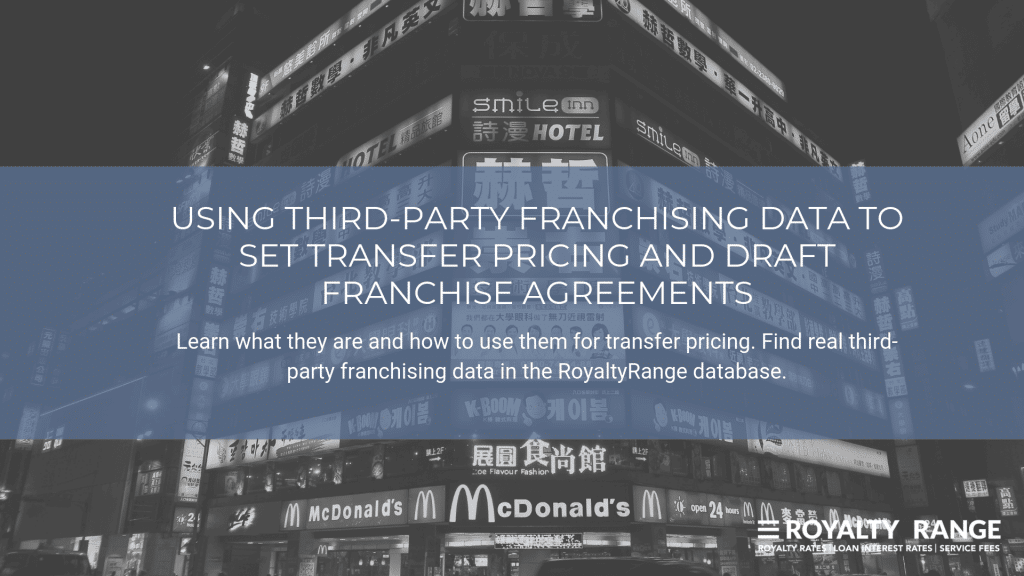Using third-party franchising data to set transfer pricing and draft franchise agreements

Kris (Kestutis) Rudzika |
June 15, 2019

Third-party franchise agreements can provide highly useful information for transfer pricing professionals analyzing franchise transactions involving intangibles. Franchise agreements typically consist of packages of intangible assets (e.g. trade names, trademarks, patents and know-how). These are licensed to the franchisee in exchange for a fee and a percentage of sales. As such, they can offer a framework for understanding the arm’s length nature of transactions involving intangibles.
They can also provide guidelines for professionals looking to value their intellectual property and draft new franchise agreements. By accessing and drawing on reliable, comparable franchising data, you will be able to set franchising royalties and terms that meet the arm’s length standard.
Whether you are a transfer pricing professional or are drafting a franchise agreement, you can now search the RoyaltyRange database for recent franchise agreements between unrelated parties. Scroll to the bottom of the page to start searching for franchising data with our One Search service.
What are franchise agreements?
So, what are franchise agreements? In a nutshell, a franchise agreement is a legal contract between a franchisor and franchisee that outlines the arrangement between the two parties. It includes information such as the intellectual property (IP) being licensed, the duration of the license, terms and conditions, remuneration, limitations of use and each party’s obligations.
Under a franchise agreement, a franchisor licenses the rights to certain intangibles to a franchisee. This enables the franchisee to build a business using the franchisor’s assets. In exchange for the use of the IP (e.g. trade names, trademarks, patents and know-how), the franchisee pays the franchisor a fee and a percentage of sales or profits (known as royalties). This sort of arrangement is mutually beneficial for both parties. The franchisee receives all the tools they need to open a business (including the already established reputation of the brand). And the franchisor can expand their brand and revenue without investing in and managing each individual establishment.

The OECD’s franchise agreements definition
The Organisation for Economic Co-operation and Development (OECD) provides the following franchise agreements definition in its glossary of statistical terms:
“Franchising is a special type of vertical relationship between two firms usually referred to as the ‘franchisor’ and ‘franchisee’. The two firms generally establish a contractual relationship where the franchisor sells a proven product, trademark or business method and ancillary services to the individual franchisee in return for a stream of royalties and other payments.”
Franchise agreements examples
Franchise agreements are particularly common in the food industry – coffee shops and fast food restaurants often use a franchise model. Some examples of franchises are McDonald’s, Costa Coffee, Domino’s Pizza and Subway. Other industries also use franchise models: for example, automotive repairs, cleaning, and retail businesses. The packing, shipping and printing company The UPS Store and the real estate company RE/MAX are both franchises.
An example of a franchise agreement is as follows. A franchisor operates coffee stores under its trade name. It decides to franchise its brand (including its know-how, trademark, patents and trade name) to a franchisee who operates food and beverage establishments. Under this license agreement, the franchisee is able to set up and operate coffee stores, kiosks and vending machines under the licensed trade name. The franchisee is allowed to use the licensed IP for five years and must pay the franchisor a royalty of 7% of sales for the duration of that time.
If you want to see real franchise agreements examples, you can find them quickly by searching the RoyaltyRange royalty rates database. We keep our database updated with recent franchise agreements covering a wide range of industries, intellectual property types and geographies.
Franchise agreements can help you determine arm’s length transfer pricing for transactions involving intangibles
Whether you are drafting a franchise agreement between related parties or carrying out a transfer pricing analysis on a controlled franchise transaction involving intangibles, you can gain a lot by looking at real franchise agreements. These agreements will help you understand the arm’s length nature of the transactions – for example, the distribution of risk between the individual parties. Ultimately, franchising data will help you set arm’s length transfer prices for your franchise transaction.
Valuing your intellectual property, drafting franchise agreements and setting appropriate royalty rates
Third-party franchising data can also be immensely useful for professionals who are drafting franchise agreements or negotiating franchise royalties. By looking at comparable franchise agreements, you will be able to grasp a solid idea of reasonable remuneration requirements. By having recent market data to draw on, you will also strengthen your negotiating position.
There are a number of methods that you can use to value your intellectual property and set reasonable royalty rates for your franchise agreement. Whichever method you choose, you should compare the remuneration you decide upon with the royalties earned in real franchise agreements.
The most popular intellectual property valuation methods are:
- The market approach – You base the remuneration in your transaction on that earned in comparable franchise agreements.
- The income approach – You base the franchise fees on the expected income generated by your intellectual property.
- The cost approach – You determine the value of your IP by calculating the cost of developing an equal or similar IP asset.
Get real franchising data today
Body: You can now find real third-party franchise agreements in the RoyaltyRange royalty rates database. It is quick, easy and reliable to use. Simply enter your search criteria into the One Search box below. Within just a few hours, you will get data on real franchise agreements that you can use for conducting a transfer pricing analysis, drafting a franchise agreement and more.
Request One Search
We will perform the search and deliver the initial results within hours, at no cost.




